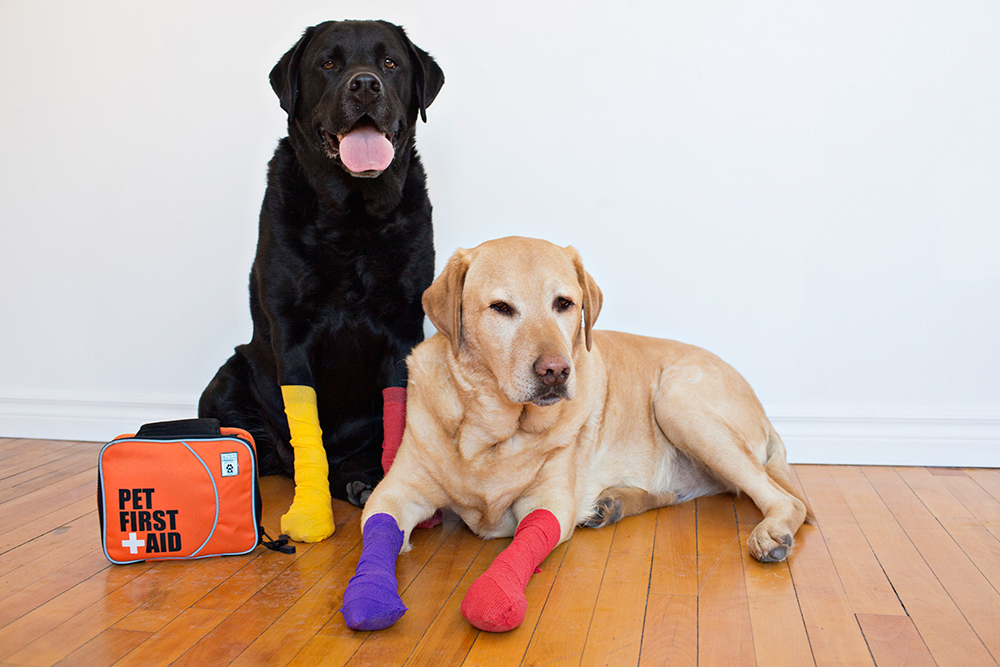
It’s vital to know how to react when your pet has an emergency. Whilst mindset is important, and I often share tips on how to stay calm in a crisis, there are some really practical things you need to know that could make the difference between life and death for your four legged friends.
With that in mind, today I am featuring the lovely Shannon Nicholson, who will give us some invaluable pet first aid tips and hopefully inspire you to learn more about being a first class First Aider for your pets.
Shannon Nicholson is a professional firefighter, pet first aid instructor and proud mother of two precocious Labrador Retrievers Mack & Spencer. Her vast hands on experience dealing with emergencies and real life animal stories assist participants with numerous ways in which to keep their pets safe and in the event of an emergency empower them with awareness and more importantly the confidence to react.

The first step to increasing the chance of “happily ever after” for your four legged family member(s) is learning Pet First Aid.
You’re asking why do I need to learn Pet First Aid, I can and will take my pet to the vet. Like us humans; who occasionally require care from a doctor so do our pets from the veterinarian. Unfortunately us humans we also enjoy the perks of emergency services; our knowledgeable and proficient paramedics and firefighters who show up when there’s an emergency to assist us. Now I know some communities that have private Pet Ambulances but this is an itty-bitty percentage so that leaves YOU, to be the 911 for your Cat or Dog!
1. Pet First Aid training prepares you to take immediate steps in an emergency.
For anyone who’s learned First Aid (for humans), you’ve been taught to approach the victim introduce yourself and ask if you can help. How do you think this would go over with a dog that has been hit by a car? Chances are they will harm faster then you can say your name, simply out of fear. Even your own beloved pet will act unpredictable when seriously hurt. Difference between human and animal: animals must be approached in a submissive manner, and muzzled before attempting to assess, treat or transport. Even an unconscious animal could wake and bite you!
2. Pet First Aid training trains you to understand the steps to take if your beloved pet was poisoned.
Take a look at Pet Insurance claims and the number one incident for pets is poisoning. Do you know what to do if your pet is poisoned? Some of the most common poisons in your household are: Raisins/grapes, mushrooms, marijuana, lily, walnuts, onion, sago palm, macadamia nuts, azalea plant, hydrangea and poinsettias. Quick tip to know if a plant could be poisonous: shiny leaves = high oil content, also bulb plants in large quantities can be extremely dangerous as well. Poisoning can occur through ingestion, inhalation, injection and contact. If you suspect your pet has been poisoned its imperative you save a sample of vomit and bring if possible the item your pet consumed, breathed in, rubbed up against, or was injected by (think insect). This will assist your veterinarian in treatment.
3. Pet First Aid training teaches you to handle bleeding wounds, bone injuries and how to perform artificial respiration and CPR on your cat or dog.
Picture this in your mind; your energetic Jack Russell heads outside to chase squirrels and do his think in your backyard, before long he’s scratching at the back door to come in and low and behold he has a stick protruding out of his body, his side has been splayed open from elbow to knee (I will save the gruesome details!). True story! A friend’s Jack Russell literally ran around and was punctured by a tree limb. The moral of this story, being prepared, having a Pet First Aid kit on hand along with understanding the steps on how to treat these crazy emergencies is the difference between happily ever after or possibly a sad good bye.
4. Pet First Aid training shows you what to do if your pets choking Learning how to deal with your pet choking is truly a life saving measure.
If the airway in your pet becomes completely blocked you only have a couple minutes to unblock it and allow the flow of oxygen in to replenish the heart. There will be no time for you to drive to the vet. True story: Gentleman was hiking with his dog on a trail and the dog carrying a stick got it lodged down its throat, the gentleman was unable to assist and his dog died within minutes. Don’t think this is going to happen to you? Look up the stats on how many humans die of choking on hot dogs in a year.. Now think of what your dog puts in its mouth.
5. Pet First Aid training educates on heat and cold injuries.
It’s a story we see to often, dog locked in a hot car and not always with a positive ending. Often we want to cool the animals quickly to bring their temperature back to normal; the problem with this is it can be deadly in itself. You can send an animal with hyperthermia into hypothermia. Its best to place the animal in the shade, give tiny quantities of tepid water, mist with a light spray of water and allow the body temperature to lower slowly. It’s also imperative you monitor their temperature and don’t cool them to much. This same logic applies to cold injuries; a dog that has been left out in the cold to long can experience hypothermia and needs to be warmed slowly. In both circumstances SHOCK can take over and kill the animal. Oh and that’s another thing you can learn about in PFA training. SHOCK. If the injury itself doesn’t kill your pet SHOCK will in many cases.
These 5 reasons are a small sampling of what you could learn in Pet First Aid Training.
It’s important you do your research when considering taking a course and getting certified, the more it compares to a curriculum that matches the human the better, meaning the subjects covered are extensive. The more you learn the better your chances are for helping your pet in an emergency.
In the meantime here are 3 of my favourite tips to help you:
#1. Invest in a PET FIRST AID kit.
Be prepared for the unexpected. Tip: Add Veterinarian and Emergency clinic phone numbers to your mobile phone contacts and Pet First Aid kit for quick reference.
#2. Keep records for each of your pets.
Track your cat or dogs weight, dietary habits, how often they eat, do they gobble or pick away, # of poops and pee’s per day, along with colour and smell Notice any lumps, bumps, weird odours from their skin or breath? This baseline data helps you to recognize a potential medical condition or emergency in your pet when their daily habits differ. It also assists your Veterinarian with diagnosing the issue at hand.
#3. Understand the POWER of Poop.
Ask any vet and they will tell you Poop is one of the best diagnostic tools for many ailments. It comes down to the 4 C’s, Colour/Consistency/Coating/Colour. Chronic diarrhea or constipation can be a medical emergency. Blood in stool is ALWAYS an emergency. Poop can also tell us when our pet has parasites, Be a poop picker upper so you got the scoop on your pets POOP!
Didn’t you learn a lot from this? I sure did and want to give a huge thank you to Shannon for sharing her tips with us. If you want to find out more about her work, visit her website, Mack and Spencer where you can see some fabulous pictures of those sweet labradors and get her free pet first aid guide.
There are pet first aid courses worldwide, I’m sure there is one near you. Here are a few possibilites as a starting point to finding one.
USA http://www.walksnwags.com
UK http://www.animalaiders.co.uk/
Ireland http://petproblemsanimalfirstaid.weebly.com/
If you have a pet first aid story to share, let me know in the comments section below.
Thank you.



[…] person at the scene of the incident. Last year I asked Pet First Aider Shannon Nicholson to write this blog post about the topic, which lists worldwide resources for learning Pet First Aid. You can buy Pet […]